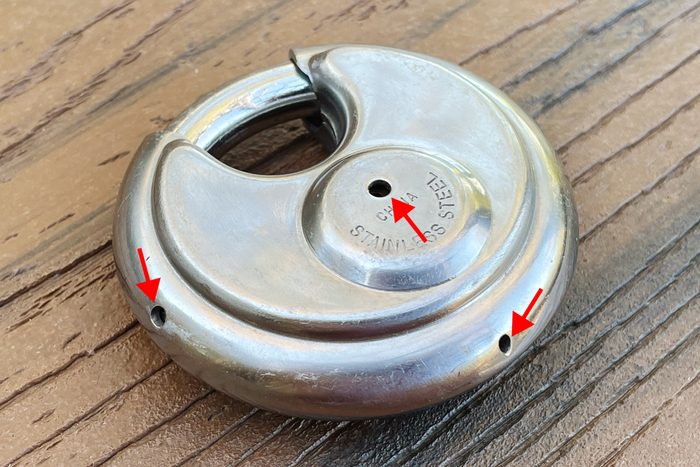If You See a Hole at the Bottom of Your Padlock, This Is What It’s For

Pin holes serve two main purposes to promote the long-term functionality of this home security staple.
Whether they’re used on the door of a tool shed, a storage cubby, or even an old-school locker, padlocks have long offered a reliable and affordable security solution. Thanks to their simple design and strong hold, they’ve stood the test of time to help many people burglar-proof their homes and prevent their belongings from being stolen.
But one mysterious feature has eluded the understanding of even the most dedicated users: those small holes located at the bottom. Well, it turns out those aren’t just manufacturing errors—they’re called pin holes and they serve a specific purpose to improve the functionality of the lock.
What Is the Pin Hole in a Padlock For?
Pin holes have two main uses: helping the lock drain any water stuck inside and helping the user lubricate the padlock if it’s stuck. Both are invaluable functions, so let’s dive into how the pin hole performs them.
It Acts as a Drain Hole
The manufacturers of padlocks cleverly realized that many locks would be used in outdoor settings, such as to secure bicycles, cellar doors, or even seaside freight containers. And for a lock to survive the unpredictable elements, it needed to be able to drain any water that would get trapped inside, either through rain or amphibious use.
This is first because the locks would rust if in contact with excess water, particularly salt water. Second, if water were to get trapped inside the small metal vessel and then freeze in lower temperatures, the expansion of the ice could break the internal mechanisms. Both of these situations would render the lock unstable.
Thus, manufacturers developed the drain holes, which allow water to easily flow out of the lock, ensuring it maintains its functionality in all environments.
It Can Help You Open the Padlock If It’s Stuck
Another common pain point with padlocks is that the internal mechanisms can get stuck, due to naturally accumulating dust and particles. To un-stick them, they need to be lubricated properly, but that’s impossible without a plausible entry point. Enter the pin hole.
To properly lubricate a padlock, first use pressurized air on the pin holes and shackle opening to blow the dust out. Then, squirt a drop or two of lock lubricant or engine oil into the pin holes and shackle opening. To evenly distribute the lubricant, tap the lock on a surface several times, then shackle and unshackle it.
To ensure peak performance, lubricate your lock every 3 to 6 months. Furthermore, do not use WD-40, which will dry out the locking mechanism, and use a pencil only in a pinch.
Other Dependable Locking Systems
Though the padlock is undeniably an ingenious tool, all this talk of security may have you thinking about other ways to beef up your home systems. Fortunately, there are a wide array of security solutions in our modern world, from portable locks, braces and security bars to keypads and smart locks. With just a little research, you’re sure to find a lock that fits your needs and budget.


